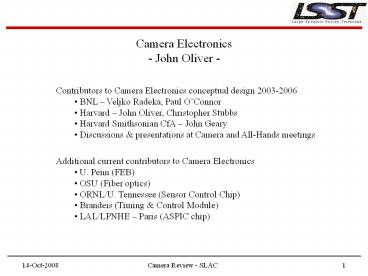Camera Electronics - PowerPoint PPT Presentation
Title:
Camera Electronics
Description:
Camera Electronics - John Oliver - Contributors to Camera Electronics conceptual design 2003-2006 BNL Veljko Radeka, Paul O Connor Harvard John Oliver ... – PowerPoint PPT presentation
Number of Views:43
Avg rating:3.0/5.0
Title: Camera Electronics
1
Camera Electronics - John Oliver -
- Contributors to Camera Electronics conceptual
design 2003-2006 - BNL Veljko Radeka, Paul OConnor
- Harvard John Oliver, Christopher Stubbs
- Harvard Smithsonian CfA John Geary
- Discussions presentations at Camera and
All-Hands meetings
- Additional current contributors to Camera
Electronics - U. Penn (FEB)
- OSU (Fiber optics)
- ORNL/U. Tennessee (Sensor Control Chip)
- Brandeis (Timing Control Module)
- LAL/LPNHE Paris (ASPIC chip)
2
Critical specs and decisions
Read noise 5 e rms
Read time 2 sec
FPA size 3,200 MPixels
Full well 105 electrons
Xtalk 0.01
3
Critical specs and decisions
Read noise 5 e rms
Read time 2 sec
FPA size 3,200 MPixels
Preamps in cryostat as close as possible to
sensors
Full well 105 electrons
Short sensor to preamp cables
Xtalk 0.01
4
Camera conceptual models BEE in or out of
cryostat
Cryostat
Sensors
FEE
FEB/BEB connections
BEE
Data fibers
Timing Control
Ethernet setup Command
Power conversion
Mains
5
Decision time BEE in or out?
- FEB to BEB connections 24 differential analog,
power ,bias, control - 120 pins per FEB/BEB combination (redundant
power pins) - 6 FEB/BEB pairs per crate ? 720 pins per crate
- 25 crates ? 18,000 pins
6
Decision time BEE in or out?
- Concern about massive feedthrough count
- Judgment that additional pcb area in cryostat
could be made contamination free with suitable
materials (polyimide) and coatings (Parylene) - Strict attention to contamination issue in
Camera design materials certification
- BEE in cryostat
- 30 conductor feedthroughs per Raft
- 600 total
- Shortest FEB/BEB cables
- 2x pcb area
7
Additional features of baseline design
- Separation of functionality
- Front End
- Analog only
- - 100C thermal zone
- Back End
- ADCs, digital only, housekeeping, data
formatting, data fiber output - - 40C thermal zone
- ASIC based analog functions (Sensor Control
Chip, ASPIC) - Differential signaling only on interconnects
LVDS, differential analog - Single timing source Timing Control module
(outside cryostat) - Fully synchronous readout All rafts do the
same thing at the same time - Flexible and fully configurable Readout State
Machine (FPGA based) - Robust grounding no ground loops within camera
- To outside world (CCS, DAQ) camera appears as
- Ethernet addresses for setup and high level
command (eg READ) - Mains power input
- Data fibers to DAQ
8
Questions
- Signal buffering on Sensor packages
- Double source follower, single source follower,
or external fet Under discussion with vendors - Critical spec is output impedance lt 1kW
- Need low time constant on cable
- Thermal control loop on sensor packages
- Temp sensor on package
- Heater resistors on package or thermal straps
- Target /- 1C absolute, /- 0.1C stability
- Heater dissipation 0.25 to 0.5 W per sensor
(biased at midpoint) - Electronics prototype effort
- Low channel count discrete prototypes
(Harvard/Penn) ? Demonstrated 1.8 ADC count
pedestal width - ASIC/ADC prototype (LAL/LPNHE) ? Demonstrated
electronic xtalk 0.007 , Noise performance
close but problem understood in simulations
(1/f problem) - Full channel count BEE, partial channel count FEE
ASIC based in progress - Raft tower, Raft Control Crate mechanical designs
done, thermal models in progress
9
Questions
- Contamination
- Polyimide pcb technology
- Parylene coating
- SLAC materials certification facility
- Synchronization
- Each Raft Control Module (in RCC) is synched to a
single common Timing Control Module with a
single master clock (50 MHz) - Full synchronicity across focal plane to several
nanoseconds skew, and sub-nanosecond jitter. - Xtalk
- Measured electronic crosstalk 0.007 from ASPIC
through data output interface - Will be dominated by sensor to preamp cable (high
density design). - Modeling, designing, and testing of this cable
interface is a critical item. - Power distribution, filtering, static protection
- Power delivered separately to all rafts
- Power sequencing envisioned for supplies in
Utility Trunk - Filtering, bypassing, and sub-regulation done at
all links in the chain.
10
Questions
- Electronic failures
- Failure rate of silicon devices expected to be
exceedingly low at reduced temperatures. - Connector pins are expected to dominate ? These
have been chosen exceedingly conservatively - Redundant pins when possible
- Possible failure scenarios
- Single channel (segment)
- Single half sensor (top or bottom row of 8)
- Single sensor
- Row of three sensors
- Entire raft
- Diagnostics in place at many levels of the chain
- Repair scenario
- Modular construction
- Replace faulty crate (Raft Tower or Raft Control
Crate) - Service faulty crate/card/connector/cable in
service facility and recertify for future use.
11
Questions
- Power dissipation heat removal
- Radiated power through lens ½ W per sensor
- FEE electronic power 1.5 W per sensor
- BEE electronic power 2 W peak, per sensor
- Note Idle mode available on both FEBs, and
BEBs. Potential for substantial power savings
active during READ only. - Turn-on times for Idle Mode for BEBs have been
measured and are small ( mseconds) - All heat removal is through conduction
- Chip scale packages where available
- Heavy thermal planes
- Heat transmitted to crate
- Taken out by cryoplate (Raft Tower) and coldplate
(Raft Control Crate) - Thermal models used during design and updated as
necessary































